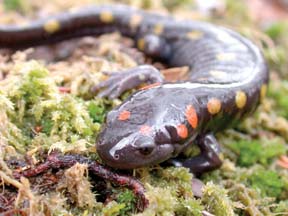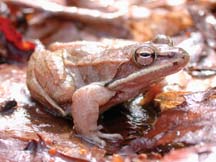Spring Showers Bring More Than Flowers
By Kathy Reshetiloff
Throughout the Northeast, spring rains are creating temporary pools in woodlands and meadows known as vernal pools. Vernal pools, though often small and inconspicuous, are coming alive as frogs, toads, salamanders, and other amphibians converge on them to breed.
 The Greek word “amphibios” literally means creatures with a double life. Amphibians spend part of their lives living in water and part living on land. Most amphibians lay soft eggs in water. The eggs hatch into an aquatic larval stage which looks and acts quite different than the more terrestrial adult stage. For instance, toad and frog eggs hatch into tadpoles, which can only survive in water. As the larvae grow, they experience radical physiological changes—a process known as metamorphosis—that transforms them into adults. The Greek word “amphibios” literally means creatures with a double life. Amphibians spend part of their lives living in water and part living on land. Most amphibians lay soft eggs in water. The eggs hatch into an aquatic larval stage which looks and acts quite different than the more terrestrial adult stage. For instance, toad and frog eggs hatch into tadpoles, which can only survive in water. As the larvae grow, they experience radical physiological changes—a process known as metamorphosis—that transforms them into adults.
Vernal pools provide a temporary aquatic environment that supports both the eggs and larvae of amphibians. Since vernal pools are isolated from other water sources, they do not support fish species that would prey upon amphibian eggs and larvae. Despite their name, vernal pools can also fill during autumn.
Some salamanders, like the marbled salamander (Amystoma opacum), will actually begin their breeding cycle in fall, migrating to pools and depositing eggs. The larvae overwinter in the pool. Other salamanders, like the spotted salamander (Amystoma maculatum), will wait until spring to visit pools and lay their eggs. Many salamanders actually return to their birth pool to breed.
Unlike quiet salamanders, toads and frogs converge on vernal pools and call to attract mates. Frogs produce their calls by moving air back and forth over the vocal cords, making them vibrate and produce sounds. So although you may not see them, you can identify what species are breeding by listening to their calls.
 Wood frogs (Rana sylvatica), migrate to vernal pools early in the spring, often before snow and ice have completely melted. The call of the wood frog is a hoarse, clacking sound, reminiscent of a quack. The wood frog is an explosive breeder, usually laying a large mass of eggs in a few days and leaving soon after. Wood frogs (Rana sylvatica), migrate to vernal pools early in the spring, often before snow and ice have completely melted. The call of the wood frog is a hoarse, clacking sound, reminiscent of a quack. The wood frog is an explosive breeder, usually laying a large mass of eggs in a few days and leaving soon after.
Spring peepers (Hyla crucifer), a tree frog, follow the wood frog by a week or two. From February to March, spring peepers leave the trees to mate in open water. Its unmistakable mating call, the peep, and large geographic range makes the spring peeper one of the most familiar frogs in North America. The mating call can sometimes be heard up to a half a mile away.
Another familiar amphibian is the American toad (Bufo americanus). Their habitat ranges from mountain wilderness to suburban backyards. You’ll likely to find the American toad almost anywhere as long as there are moist places, plenty of insects to eat and shallow waters to breed from March to July. Despite their warty appearance, their mating call is a pleasant musical trill.
All across the world, amphibian populations are declining. Loss of forest and wetland habitat is one possible cause. Many amphibians return to the same ponds and wetlands in which they were born to breed, but if natal areas are disturbed or lost, they will not breed. Deforestation reduces woodlands needed by adults. Fragmentation is also a problem. As wooded tracts shrink in size, the remaining amphibians become isolated and inbreeding may occur, weakening the species.
Amphibians help us to measure the health of the environment. Amphibians exchange water and air primarily through their skin. In addition, they can absorb pollutants that are in the soil and water. Like a canary in a coal mine, a decline in local populations may indicate a contaminant problem. Amphibians possess many foul-tasting chemicals in their skin and glands to protect them from predators. Some of these chemicals have medicinal value. Drug companies are looking to replicate some of these compounds for heart medications, organ glues and pain killers. Aesthetically, many amphibians are extremely beautiful creatures that we should all have the opportunity to observe and enjoy.
Protecting forested wetlands and woodlands is a first step to preserving amphibians. Adults require wooded tracts, but need access to shallow aquatic habitats to breed. Vegetated buffer strips along waterways are equally important. Rivers and flood plains provide excellent corridors to connect isolated woodlands. Amphibians use these corridors to move between small pockets of existing woodlands and wetlands, helping to ensure healthy and diverse populations.
We all benefit from such actions. These same areas are habitat for a multitude of wildlife, including invertebrates, fish, birds, and mammals. Protecting woodlands, wetlands and river corridors reduces the amount of nutrients and sediment entering rivers and the Bay. The forests and wetlands offer us a retreat to enjoy the serenades from the woods. We need such a place to retreat from our increasingly concrete world.
You can help scientists monitor amphibians in your area. Volunteer in one of the programs below!
North American Amphibian
Monitoring Program
Patuxent Wildlife Research Center
12100 Beech Rd
Laurel MD 20708
301-497-5500
http://www.pwrc.usgs.gov/naamp/
Frogwatch USA
National Wildlife Federation
11100 Wildlife Center Drive
Reston, VA 20190-5362
1-800-822-9919
http://www.nwf.org/frogwatchUSA/.
Back
|

